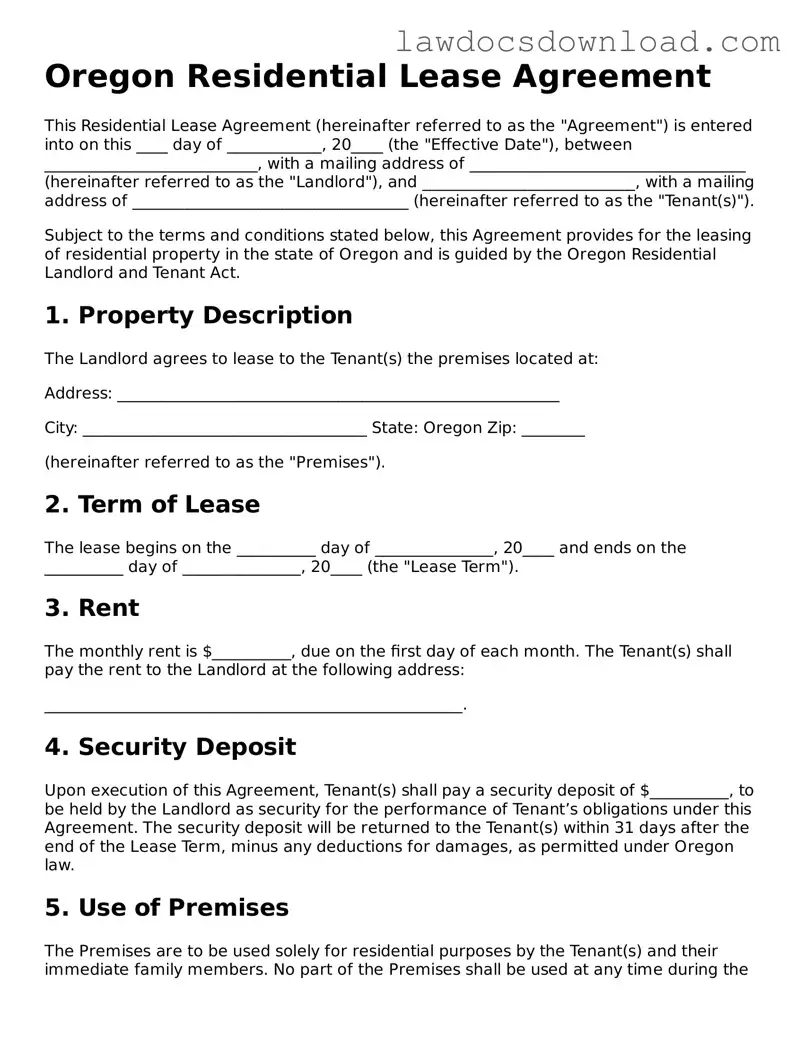Oregon Residential Lease Agreement
This Residential Lease Agreement (hereinafter referred to as the "Agreement") is entered into on this ____ day of ____________, 20____ (the "Effective Date"), between ___________________________, with a mailing address of ___________________________________ (hereinafter referred to as the "Landlord"), and ___________________________, with a mailing address of ___________________________________ (hereinafter referred to as the "Tenant(s)").
Subject to the terms and conditions stated below, this Agreement provides for the leasing of residential property in the state of Oregon and is guided by the Oregon Residential Landlord and Tenant Act.
1. Property Description
The Landlord agrees to lease to the Tenant(s) the premises located at:
Address: ________________________________________________________
City: ____________________________________ State: Oregon Zip: ________
(hereinafter referred to as the "Premises").
2. Term of Lease
The lease begins on the __________ day of _______________, 20____ and ends on the __________ day of _______________, 20____ (the "Lease Term").
3. Rent
The monthly rent is $__________, due on the first day of each month. The Tenant(s) shall pay the rent to the Landlord at the following address:
_____________________________________________________.
4. Security Deposit
Upon execution of this Agreement, Tenant(s) shall pay a security deposit of $__________, to be held by the Landlord as security for the performance of Tenant’s obligations under this Agreement. The security deposit will be returned to the Tenant(s) within 31 days after the end of the Lease Term, minus any deductions for damages, as permitted under Oregon law.
5. Use of Premises
The Premises are to be used solely for residential purposes by the Tenant(s) and their immediate family members. No part of the Premises shall be used at any time during the term of this Agreement by the Tenant(s) for the purpose of carrying on any business, profession, or trade of any kind, without the prior written consent of the Landlord.
6. Maintenance and Repairs
Tenant(s) agree to keep the Premises in a clean and sanitary condition and to promptly notify the Landlord of any damage, need for repairs, or maintenance issues. Landlord shall be responsible for repairs to the structure of the Premises and appliances provided by the Landlord, except when damage has been caused by misuse or neglect of the Tenant(s).
7. Alterations
No alterations, additions, or improvements shall be made by Tenant(s) to the Premises without the prior written consent of the Landlord. Any authorized alterations shall become the property of the Landlord and shall remain upon, and be surrendered with the Premises at the end of the Lease Term.
8. Governing Law
This Agreement shall be governed, construed, and interpreted by, through, and under the Laws of the State of Oregon.
9. Entire Agreement
This Agreement constitutes the entire agreement between the parties and supersedes any prior understanding or representation of any kind preceding the date of this Agreement. There are no other promises, conditions, understandings or other agreements, whether oral or written, relating to the subject matter of this Agreement.
10. Signatures
IN WITNESS WHEREOF, the parties have executed this Agreement as of the Effective Date.
Landlord Signature: ____________________________ Date: ___________
Tenant Signature: ____________________________ Date: ___________
